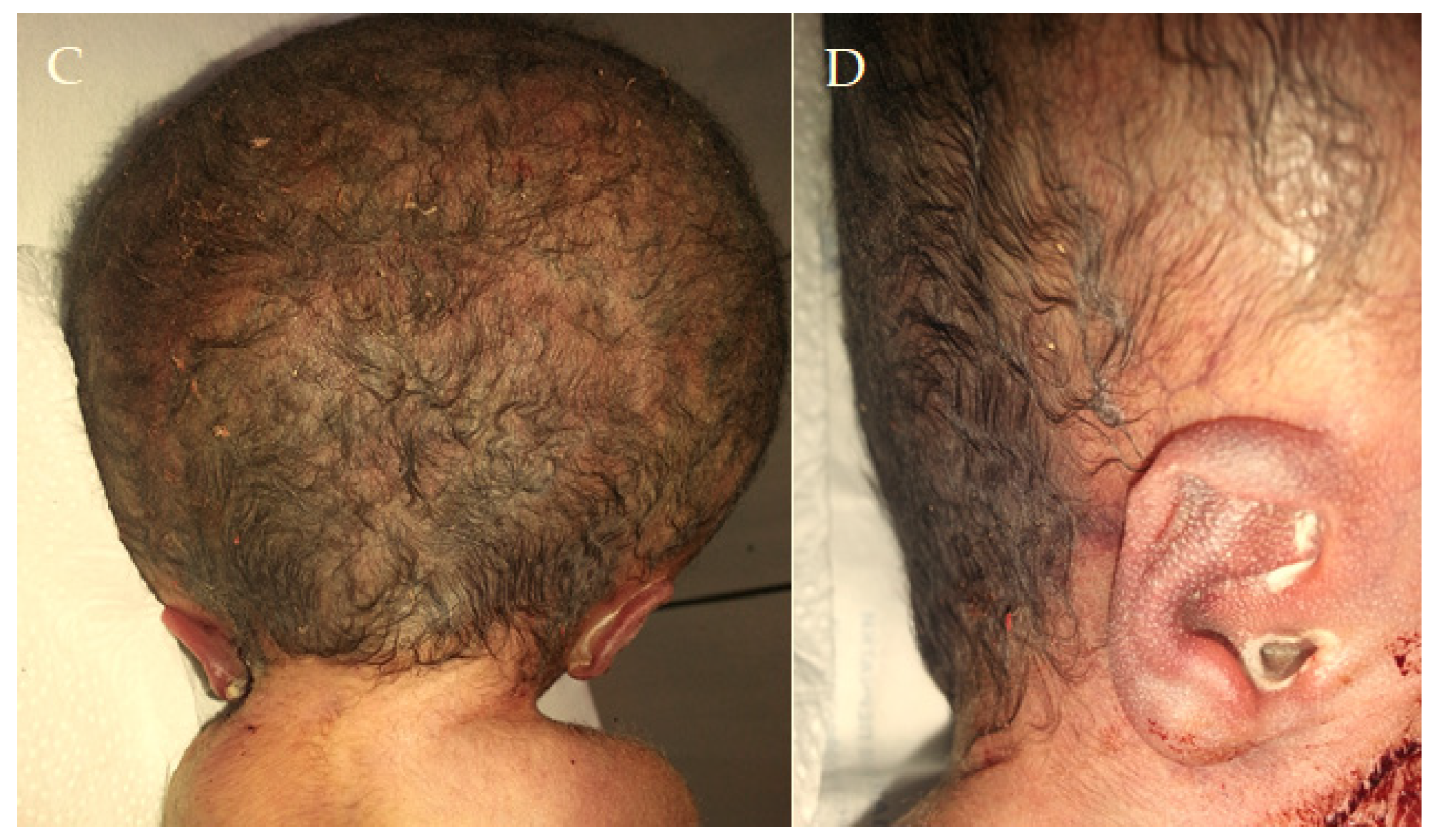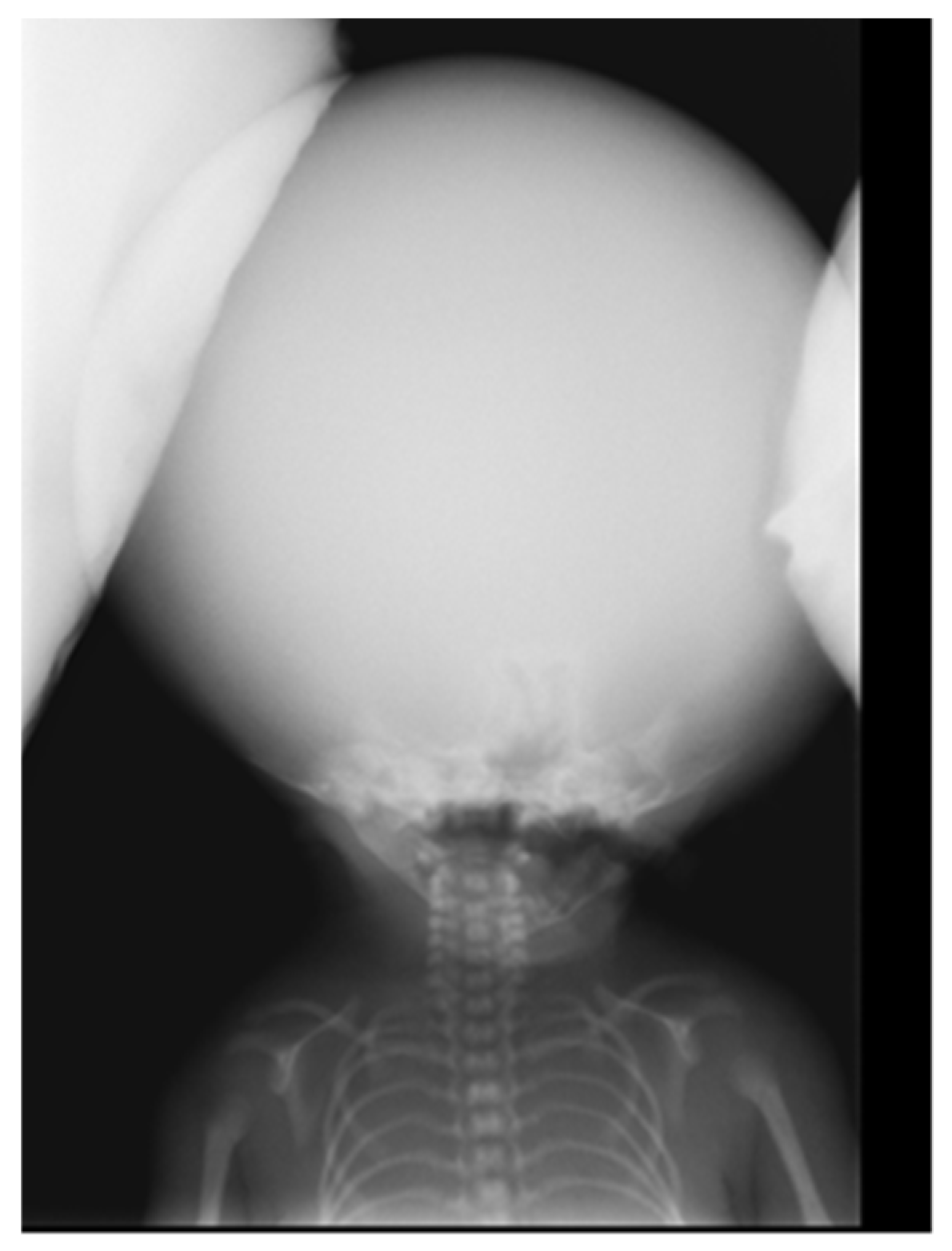Hydrolethalus Syndrome: A Case of a Rare Congenital Disorder
Abstract






Author Contributions
Funding
Institutional Review Board Statement
Informed Consent Statement
Conflicts of Interest
References
- Paetau, A.; Honkala, H.; Salonen, R.; Ignatius, J.; Kestilä, M.; Herva, R. Hydrolethalus syndrome: Neuropathology of 21 cases confirmed by HYLS1 gene mutation analysis. J. Neuropathol. Exp. Neurol. 2008, 67, 750–762. [Google Scholar] [CrossRef] [PubMed]
- Salonen, R.; Herva, R. Hydrolethalus syndrome. J. Med. Genet. 1990, 27, 756–759. [Google Scholar] [CrossRef] [PubMed][Green Version]
- Belengeanu, V.; Marian, D.; Hosszu, T.; Ogodescu, A.S.; Belengeanu, A.D.; Samoilă, C.; Freiman, P.; Lile, I.E. A comprehensive evaluation of an OFDI syndrome from child to teenager. Rom. J. Morphol. Embryol. 2019, 60, 697–706. [Google Scholar] [PubMed]
- Visapää, I.; Salonen, R.; Varilo, T.; Paavola, P.; Peltonen, L. Assignment of the locus for hydrolethalus syndrome to a highly restricted region on 11q23-25. Am. J. Hum. Genet. 1999, 65, 1086–1095. [Google Scholar] [CrossRef] [PubMed][Green Version]
- Putoux, A.; Thomas, S.; Coene, K.L.; Davis, E.E.; Alanay, Y.; Ogur, G.; Uz, E.; Buzas, D.; Gomes, C.; Patrier, S.; et al. KIF7 mutations cause fetal hydrolethalus and acrocallosal syndromes. Nat. Genet. 2011, 43, 601–606. [Google Scholar] [CrossRef]
- Lincoln, S.E.; Hambuch, T.; Zook, J.M.; Bristow, S.L.; Hatchell, K.; Truty, R.; Kennemer, M.; Shirts, B.H.; Fellowes, A.; Chowdhury, S.; et al. One in seven pathogenic variants can be challenging to detect by NGS: An analysis of 450,000 patients with implications for clinical sensitivity and genetic test implementation. Genet. Med. 2021, 23, 1673–1680. [Google Scholar] [CrossRef] [PubMed]
- Meienberg, J.; Bruggmann, R.; Oexle, K.; Matyas, G. Clinical sequencing: Is WGS the better WES? Hum. Genet. 2016, 135, 359–362. [Google Scholar] [CrossRef] [PubMed]
- Lelieveld, S.H.; Spielmann, M.; Mundlos, S.; Veltman, J.A.; Gilissen, C. Comparison of exome and genome sequencing technologies for the complete capture of protein-coding regions. Hum. Mutat. 2015, 36, 815–822. [Google Scholar] [CrossRef] [PubMed]
- Belkadi, A.; Bolze, A.; Itan, Y.; Cobat, A.; Vincent, Q.B.; Antipenko, A.; Shang, L.; Boisson, B.; Casanova, J.L.; Abel, L. Whole-genome sequencing is more powerful than whole- exome sequencing for detecting exome variants. Proc. Natl. Acad. Sci. USA 2015, 112, 5473–5478. [Google Scholar] [CrossRef] [PubMed]
- Slavotinek, A.M. Fryns syndrome: A review of the phenotype and diagnostic guidelines. Am. J. Med. Genet. A 2004, 124A, 427–433. [Google Scholar] [CrossRef] [PubMed]
- Khurana, S.; Saini, V.; Wadhwa, V.; Kaur, H. Meckel-Gruber syndrome: Ultrasonographic and fetal autopsy correlation. J. Ultrasound 2017, 20, 167–170. [Google Scholar] [CrossRef] [PubMed]
- Koenig, R.; Bach, A.; Woelki, U.; Grzeschik, K.-H.; Fuchs, S. Spectrum of the acrocallosal syndrome. Am. J. Med. Genet. 2002, 108, 7–11. [Google Scholar] [CrossRef] [PubMed]
- Hall, J.G.; Pallister, P.D.; Clarren, S.K.; Beckwith, J.B.; Wiglesworth, F.W.; Fraser, F.C.; Cho, S.; Benke, P.J.; Reed, S.D. Congenital hypothalamic hamartoblastoma, hypopituitarism, imperforate anus, and postaxial polydactyly. A new syndrome? Part I: Clinical, causal and pathogenetic considerations. Am. J. Med. Genet. 1980, 7, 47. [Google Scholar] [CrossRef] [PubMed]
Disclaimer/Publisher’s Note: The statements, opinions and data contained in all publications are solely those of the individual author(s) and contributor(s) and not of MDPI and/or the editor(s). MDPI and/or the editor(s) disclaim responsibility for any injury to people or property resulting from any ideas, methods, instructions or products referred to in the content. |
© 2025 by the authors. Licensee MDPI, Basel, Switzerland. This article is an open access article distributed under the terms and conditions of the Creative Commons Attribution (CC BY) license (https://creativecommons.org/licenses/by/4.0/).
Share and Cite
Belengeanu, V.; Marian, D.; Stana, H.A.; Cojocariu, C.; Popescu, C.; Lile, I.E. Hydrolethalus Syndrome: A Case of a Rare Congenital Disorder. Diagnostics 2025, 15, 202. https://doi.org/10.3390/diagnostics15020202
Belengeanu V, Marian D, Stana HA, Cojocariu C, Popescu C, Lile IE. Hydrolethalus Syndrome: A Case of a Rare Congenital Disorder. Diagnostics. 2025; 15(2):202. https://doi.org/10.3390/diagnostics15020202
Chicago/Turabian StyleBelengeanu, Valerica, Diana Marian, Horia Ademir Stana, Carolina Cojocariu, Cristina Popescu, and Ioana Elena Lile. 2025. "Hydrolethalus Syndrome: A Case of a Rare Congenital Disorder" Diagnostics 15, no. 2: 202. https://doi.org/10.3390/diagnostics15020202
APA StyleBelengeanu, V., Marian, D., Stana, H. A., Cojocariu, C., Popescu, C., & Lile, I. E. (2025). Hydrolethalus Syndrome: A Case of a Rare Congenital Disorder. Diagnostics, 15(2), 202. https://doi.org/10.3390/diagnostics15020202







